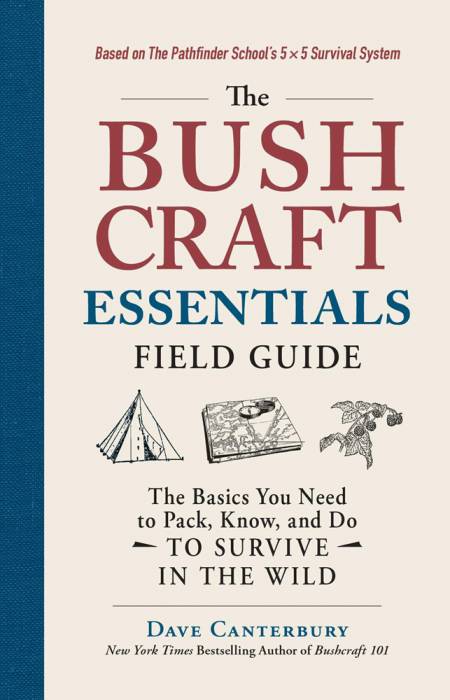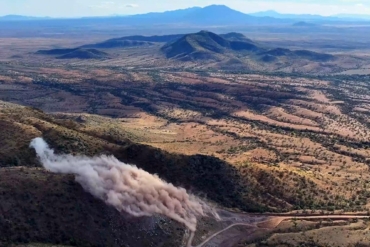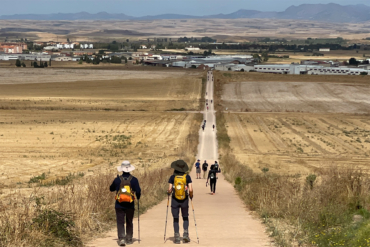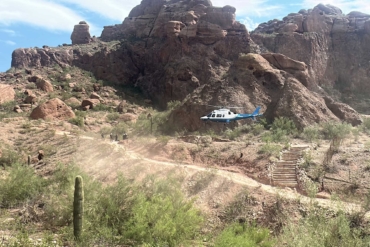When it comes to the concept of “Bushcraft,” Dave Canterbury has more or less done it all. Beyond his role as co-owner and instructor at the legendary Pathfinder School, he’s also the author of the New York Times bestsellers “Bushcraft 101” and “The Bushcraft Guide to Trapping, Gathering, and Cooking in the Wild.”
But like any good teacher, Canterbury is committed to refining his curriculum. The latest entry in his line of outdoor texts hit the shelves last month: “The Bushcraft Essentials Field Guide: The Basics You Need to Pack, Know, and Do to Survive in the Wild.”

In this volume, Canterbury compiles an easy-to-use reference manual on several of the most vital wilderness skills: “How to start a fire. Where to build your shelter. What to put in your pack … From first aid to navigation to setting up camp, it’s all provided in this small, portable book that’s perfect whether you’re on a day-hike, overnight or multi-day trek.”
GearJunkie sat down (at least digitally) with the author, in order to learn what sets this new book apart. Along the way, we discussed gear, camp cooking, and the difference between “Bushcraft” and “Survival.”
Dave Canterbury Interview
GearJunkie: You’ve written several books on bushcraft — how does the new “Bushcraft Essentials” stand out from your other volumes?
Dave Canterbury: The new book is a basic teaching and study guide. It was developed at the Pathfinder School over the last 8-10 years and gives a baseline of topics, then breaks them down for further study or with further information regarding the sub-topics and tasks within.
The “Five Cs of Survivability” (Cutting, Combustion, Cover, Container, and Cordage) are mainstays from “Bushcraft 101.” Have you added to or modified any aspects of this core teaching?
We have always had 10 Cs — the first five being of utmost importance — but the second five Cs of sustainability add functionality beyond simple survival tools in Navigation, Repair, Signaling for Rescue, and additional items for basic Self Aid.
[The other five Cs, according to Canterbury’s new book are: Cotton bandannas, cargo tape, compass, cloth sail needle, and candling device].
What’s the difference between ‘bushcraft’ and ‘survival?’
No, I believe survival in the short term begins with what you have in your kit. Let’s face it: being separated from that would be pretty rare.
Bushcraft is more of a long-term mindset, and it uses the landscape to be more comfortable in the longer term.
While good bushcraft and more primitive skills can definitely give advantages in a survival scenario (depending on what occurs), you should truly be prepared in the short term with the kit you carry, so you don’t have to worry about craftwork in an emergency.
What one or two pieces of gear should everyone bring with them into the woods?
I recommend carrying the five items in the five Cs at a minimum, but I think a knife of some sort is of the utmost importance. While I prefer that one carry a full tang knife, even a SAK [Swiss Army Knife] is better than nothing at all.
Aside from this, I would not leave the house without a Bic lighter in my pocket. Instant flames can be important when you need fire quickly, and they are very robust.
You should also have proper clothing for the environment, which provides some cover. And you will probably have cordage in the form of hood ties, belts, shoe laces, etc.
A metal container is important, but to me, it takes a back seat to fire and a simple metal tool.
What about gear that a new adventurer might think they need, but most often turns out to be dead weight?
I think we all tend to overpack at some point or in some way. The truth is, with a good grasp of woodsy knowledge, you don’t need much.
I tend to believe that people most often will overpack or take more than necessary things like food and gadgets. I often see fire kits online that has more than what five people would need, let alone a single traveler.
But we all tend to overpack or make redundancies on the things we fear the most, and fire starting in inclement weather is a skill many do not possess.
Have there been any specific advances in material or technology that have changed the way you pack?
I think that advances in the sheer weight of items are the biggest thing that makes life easier for many now.
I love my traditional heavy canvas and oilcloth, and cooking over open fires. [But] the ease of a titanium stove that weighs next to nothing, or a Polar Guard Bivvy sack that keeps you warm to 40 degrees and is multifunctional — like the Swagman Roll — gives all of us an advantage to carry a bit more and still cut the weight we are trekking with.
To me, this is a game changer.
Your YouTube channel shows a real love for outdoor cookery. Any tips on dining and cooking gear?
I think a good meal in the woods is part of the enjoyment of the outdoors. If you are just trying to make miles, then food is fuel and it really doesn’t matter that much.
But after a day of hunting or in the morning before setting out to fish or check the trap line, a good breakfast makes the day worthwhile!
You can do a lot with not much kit when it comes to cooking depending on your skill level, but I would say never underestimate a nice skillet. And a pot of coffee will always be popular.
If you could imprint one lesson into the mind of someone new to the woods, what would it be?
Learn to address the most common injuries before you venture out. We call them the five Bs: Bleeding, Breaks, Burns, Blisters, and Bites.
The “Bushcraft Essentials Field Guide” is available now, through multiple online retailers. Snag your copy for the holidays, and up your bushcraft game for the new year.







